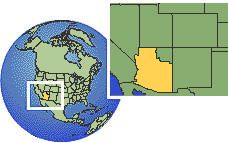Have you ever stopped to think about how time shapes the rhythm of a city? If you happen to visit or live in Phoenix, Arizona, you will quickly notice that “time in Phoenix” is not just about hours on a clock. It is also about sunshine, daily routines, cultural life, and even the way people work and rest. Phoenix is unique because its relationship with time feels different from many other cities in the United States. From its decision not to observe Daylight Saving Time to the way locals plan their schedules around the desert heat, the city has its own pace.
In this article, we will take a deep dive into what time in Phoenix really means. We will talk about time zones, how the city’s climate affects daily life, why visitors sometimes get confused about the local clock, and how culture blends with time in surprising ways. Whether you are a traveler, a new resident, or simply curious, this friendly guide will help you see Phoenix through the lens of time.
The Time Zone Puzzle: Why Phoenix Stands Out
When most people think about time in the United States, they picture the standard zones: Eastern, Central, Mountain, and Pacific. Phoenix officially belongs to the Mountain Standard Time Zone. However, unlike most of the Mountain states, Phoenix does not follow Daylight Saving Time. This decision often surprises visitors who expect the clock to “spring forward” in March or “fall back” in November.
Because of this, Phoenix aligns with Pacific Time during the summer months and with Mountain Time during the winter. For example, if you call a friend in Los Angeles in July, you will both be on the same clock. Yet in December, Phoenix lines up with Denver instead. This small twist may sound simple, but it can cause plenty of confusion for tourists, businesses, and even airlines.
The Story Behind Skipping Daylight Saving Time
Why does Phoenix resist the national trend of adjusting clocks twice a year? The answer lies in the desert sun. Summers in Phoenix are famously hot, with temperatures soaring well above 100 degrees Fahrenheit. Extending daylight into the evening hours would only make the heat harder to endure.
By keeping the clocks steady year-round, Phoenix residents enjoy slightly earlier sunsets in the summer, which helps evenings cool down faster. Families can step outside, enjoy a walk, or relax on a patio without waiting until late at night. In a city where the sun feels endless, skipping Daylight Saving Time simply makes sense.
How Visitors Experience Time in Phoenix
If you are visiting Phoenix for the first time, you might find the city’s approach to time both refreshing and a little tricky. For one thing, your phone should automatically adjust to local time, but if you are coordinating with friends in other states, you may need to double-check. A meeting planned with someone in Chicago might look one way in spring and another way in fall.
Business travelers often notice this shift most clearly. If you are flying in from New York, for instance, the time difference can range between two and three hours depending on the season. For travelers heading west from California, the gap may be zero or one hour. This constant change means paying attention to time in Phoenix requires just a little extra awareness.
The Role of Sunlight in Daily Routines
Time in Phoenix is not just about hours and minutes. It is also about the relationship between people and sunlight. Because the city enjoys more than 300 sunny days each year, the pace of life follows the brightness of the sky. Many locals wake up early to take advantage of the cooler mornings. Joggers, cyclists, and dog walkers often start their day before the sun has fully risen.
Afternoons, on the other hand, can feel slow, especially in summer. Some businesses even adjust hours, opening earlier and closing before the heat peaks. Families may plan errands or outdoor activities around the sun, making mornings and evenings the busiest times. In this way, time in Phoenix is shaped as much by weather as by the clock.
Cultural Events and the Rhythm of Time
Phoenix is not only a city of sunshine. It is also a hub for culture, sports, and community gatherings. Time plays a key role in how these events unfold. For example, baseball fans know that evening games at Chase Field bring relief from the daytime heat. Concert organizers often schedule shows later at night so attendees can enjoy the cooler desert breeze.
Seasonal events also influence the perception of time. Festivals like the Arizona State Fair or spring training baseball games are planned with careful attention to weather patterns. In many ways, the cultural calendar in Phoenix reflects the city’s attempt to balance human activity with nature’s powerful clock.
Work Life and Time Management in Phoenix
For professionals in Phoenix, managing time has its own flavor. Because of the city’s unique time zone status, businesses that deal with clients across the country must be careful. A conference call scheduled at 9 AM in New York might mean an early morning start for Phoenix employees. Similarly, coordinating with teams in California can shift depending on the season.
At the same time, the city’s growing role as a hub for tech companies and startups means flexible work schedules are increasingly common. Remote workers, especially, find Phoenix appealing because they can align their hours more easily with both east and west coast clients. This balance gives Phoenix professionals a distinctive approach to time management.
Family Life and the Value of Evening Hours
For families living in Phoenix, time after sunset feels especially precious. During the long, hot summer, daytime hours may limit outdoor play. Once the sun dips, though, neighborhoods come alive. Children ride bikes, parents chat with neighbors, and community parks fill up with activity.
Even school schedules reflect the impact of time in Phoenix. Many schools start earlier in the day to avoid the strongest afternoon heat. Parents often organize routines with the sun in mind, making sure that activities wrap up before temperatures climb too high. In this way, family life in Phoenix shows how deeply the city’s time is tied to the desert environment.
Time and Tourism in Phoenix
If you are a tourist exploring Phoenix, you will soon learn that the best experiences often depend on timing. Hikes at Camelback Mountain or South Mountain are best done early in the morning before the sun becomes overwhelming. Guided tours of the desert or nearby canyons often start at sunrise for the same reason.
Museums and indoor attractions, on the other hand, become popular in the afternoon when the sun is strongest. Tourists often structure their day around this rhythm, balancing outdoor adventure with indoor comfort. Understanding the local sense of time can make a big difference in how much you enjoy your visit.

Historical Shifts in Timekeeping
The way Phoenix handles time today has roots in its past. In earlier decades, the city experimented with Daylight Saving Time like the rest of the country. However, the policy never fit the desert lifestyle. Local leaders eventually pushed for consistency, choosing a steady time zone that better matched community needs.
This decision shaped not only daily routines but also the city’s identity. Today, Phoenix is one of the largest American cities that proudly resists seasonal clock changes. This choice sets it apart and reflects the independent spirit often associated with the Southwest.
The Psychological Side of Time in Phoenix
Living in a place with endless sunshine also affects how people feel about time. Many residents say the abundance of light makes their days feel longer. Others note that the lack of seasonal shifts in daylight hours provides a sense of stability. Unlike northern cities where winter days feel short and gloomy, Phoenix offers a consistent pattern.
At the same time, the constant brightness can be overwhelming for newcomers. Adjusting to the rhythm of the sun may take weeks or even months. Once people settle in, however, they often find that Phoenix gives them a new appreciation for time and energy.
Balancing Tradition and Modern Demands
Time in Phoenix also reflects a balance between tradition and modern life. On one hand, the city respects its natural environment by avoiding artificial clock changes. On the other hand, it adapts to the needs of a growing, modern economy. With new industries, an expanding population, and global connections, Phoenix continues to find creative ways to manage time.
This balance shows up in everything from business schedules to cultural events. It also demonstrates how cities can adapt to both nature and progress without losing their identity.
Comparing Phoenix to Other Cities
To truly understand time in Phoenix, it helps to compare it with other places. Cities like New York or Chicago experience dramatic seasonal shifts in daylight. They embrace Daylight Saving Time as a way to maximize sunshine. In contrast, Phoenix’s constant sun makes such adjustments unnecessary.
Western cities like Los Angeles or Las Vegas share some similarities with Phoenix, especially in the summer when clocks align. However, their coastal influence means cooler evenings, while Phoenix relies on its early sunsets for relief. These comparisons highlight how unique Phoenix really is in its relationship with time.
Technology and the Future of Time in Phoenix
As technology shapes modern life, timekeeping in Phoenix may continue to evolve. Smartphones, smart watches, and digital assistants already help residents manage their schedules across different time zones. Businesses rely on advanced software to coordinate meetings worldwide, making the city’s unusual time zone less of a problem.
Still, the human side of time in Phoenix will remain important. No app can change the desert sun, which continues to dictate daily routines. Looking ahead, Phoenix will likely keep blending modern tools with its natural rhythm, creating a unique balance between tradition and innovation.
Why Time in Phoenix Teaches Us Something Bigger
At first glance, time in Phoenix might seem like a small detail, just another fact about a city. Yet the more you explore it, the more it reveals about how people adapt to their environment. The city’s decision to skip Daylight Saving Time is not just about clocks. It is about respecting nature, protecting comfort, and building a lifestyle that fits the desert.
This lesson can inspire anyone, no matter where they live. Time does not always have to follow the same pattern everywhere. By observing Phoenix, we see how communities can design schedules that match their unique needs.
Final Thoughts on Time in Phoenix
So what is time in Phoenix really about? It is a blend of sunshine, culture, practicality, and individuality. It is about mornings filled with energy, afternoons shaped by heat, and evenings spent under cooler skies. It is about skipping Daylight Saving Time not out of rebellion, but out of common sense.
If you ever find yourself in Phoenix, pay attention to how the city treats time. Notice how locals rise early, how families cherish evenings, and how businesses adapt to both coasts. You will discover that time in Phoenix is not just measured in hours. It is measured in sunlight, in community, and in the simple joy of living life in sync with nature.


